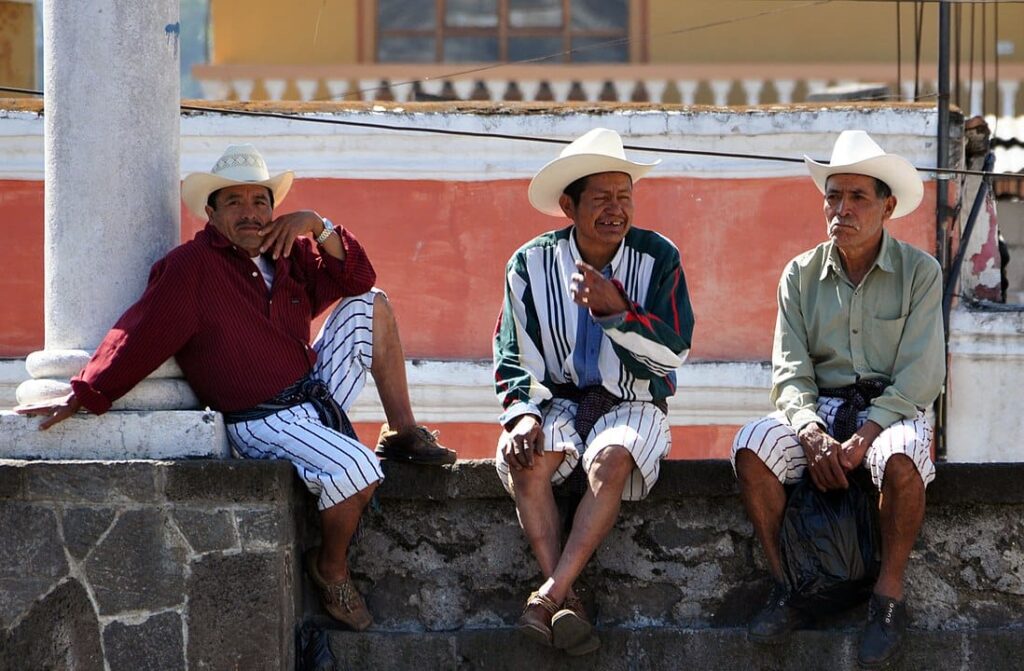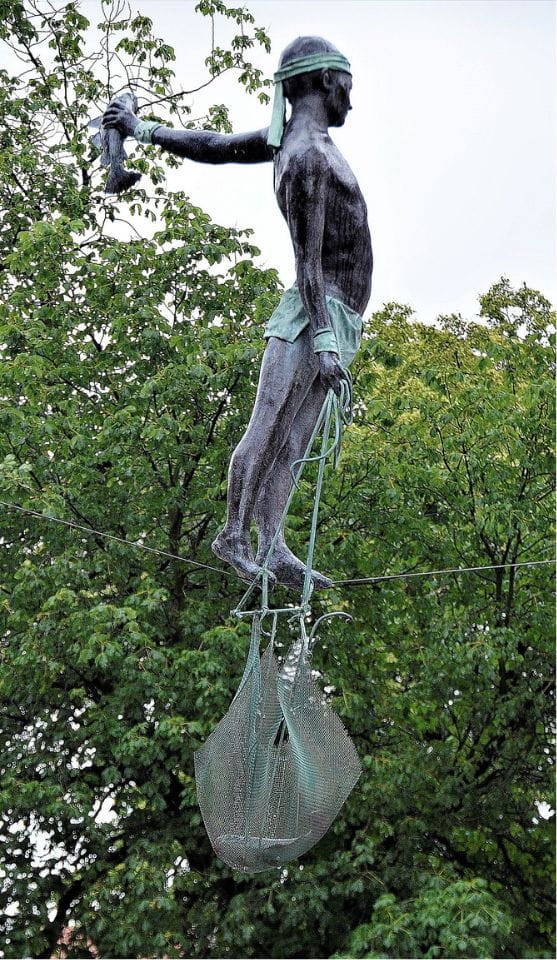Breathtaking Lake Atitlán, nestled in Guatemala’s Highlands, captivates with its sparkling blue waters embraced by towering volcanoes and vibrant green hills. This picturesque location is a favorite among digital nomadesses. Still, not everyone realizes that its surroundings are a hub of several indigenous tribes on Lake Atitlán, Guatemala, each possessing their distinct culture and traditions.Among its surroundings, the Tzʼutujil and Xinca tribes have created a distinct cultural mosaic, preserving their rich ancestral customs and traditions.Breathtaking Lake Atitlán, nestled in Guatemala’s Highlands, captivates with its sparkling blue waters embraced by towering volcanoes and vibrant green hills. This picturesque location is a favorite among digital nomads. However, not everyone realizes that its surroundings are a hub of several indigenous tribes. Among these, the Tzʼutujil and Xinca tribes have created a distinct cultural mosaic, preserving their rich ancestral customs and traditions.
Santiago Atitlán is the focal point of this narrative.
Situated along the southern fringes of Lake Atitlán, Santiago Atitlán represents a Guatemalan municipality nestled within Sololá’s administrative boundaries. It’s the largest of the lake-side towns and, more importantly, is notable for being home to the Tz’utujil people, one of the country’s indigenous Maya groups. This place, known for its deep-rooted ties to the Maya heritage, teems with locals who speak Tz’utujil and embrace their culture by donning traditional garb.
Santiago Atitlán
Santiago Atitlán is a municipality in the Sololá department of Guatemala, located on the southern shores of Lake Atitlán. It is the largest of the lake-side towns and is notable for being home to the Tz’utujil people, one of the country’s indigenous Maya groups. The town is known for maintaining a strong connection to traditional Maya culture, with many inhabitants speaking the Tz’utujil language and wearing traditional clothing.
In addition to its breathtaking lake vistas and deep-seated Maya roots, Santiago Atitlán serves as a thriving hub for artistic minds who breathe life into their creativity via mediums such as weaving, painting, and wood carving; each piece is far from ordinary – instead being infused with traditional Maya motifs that render them intriguingly distinct. Maximon, a revered folk deity embodied in diverse ways across the highland Maya societies of Western Guatemala, holds an esteemed position within Santiago Atitlán’s rich cultural fabric. A unique aspect of Santiago Atitlán is the cofradía of Maximon, where the effigy of the saint is housed and can be visited by locals and tourists.
Surrounded by high volcanoes, the town provides breathtaking views and is a popular destination for both national and international tourists. Despite the tragic history of violence during the Guatemalan civil war, the people of Santiago Atitlán have demonstrated resilience and continue to preserve and promote their unique cultural heritage. Despite the efforts of governments to crush them.
The Xinca people
The Xinca people, another tribe in the Lake Atitlán vicinity, may not be as populous as the Tzʼutujil people, but they play a vital role in the region’s cultural mosaic. Residing in Guatemala’s highlands for countless generations, the Xincas are recognized for their traditional attire, which typically includes vividly colored skirts and intricately embroidered blouses. They are adept farmers and craftsmen, known for their handmade arts and crafts, and pottery. Their distinctive culture enhances the diverse richness of the Lake Atitlán area.

https://commons.wikimedia.org/wiki/File:Santiago_de_atitlan_natives_2009.JPG
the Tzʼutujil Tribe
The largest tribe around Lake Atitlán is the Tz’utujil people. Comprising one of the 22 Mayan communities residing in Guatemala, their population is approximated to be close to a hundred thousand individuals. Immersed in their indigenous heritage, the Tz’utujil tribe is distinguishable through its unique attire – imagine vibrant skirts adorned with purple stripes and huipiles bustling with intricate bird and floral patterns; a striking symbol of their cultural richness.
The saga of the Tz’utujil tribe extends far back into the annals of this region’s history. Over centuries, these individuals have established their roots around Lake Atitlan’s periphery, progressively shaping a cultural tapestry that is entirely their own, teeming with distinctive traditions and customs. Their hallmark is the art of textile creation, a craft transmitted through generations, coupled with their farming techniques which majorly involve the propagation of maize, legumes and gourds.
Geography Of The Area
The lake was formed in the crater of a volcano that erupted approximately 84,000 years ago. The volcano’s explosion dispersed ash over an area of some 6,000,000 square kilometers, which has been detected from Florida to Ecuador. The ash can be used as a stratigraphic marker in both the Pacific and Atlantic oceans and is known as Y-8 ash in marine deposits.
The lake is situated in a valley dammed by volcanic ash, and its shores are dotted with Indian villages. The area around the lake is lush and green, with a tropical climate that is perfect for growing coffee, bananas, and other crops. The region is also prone to earthquakes, which are caused by the tectonic activity in the area.
Apart from Lake Atitlán, the region is also home to Lake Amatitlán, which has significant archaeological importance. The area around Lake Amatitlán has yielded several artifacts from the ancient Maya civilization, including pottery, stone tools, and human remains. The only C-14 date for the Lake Amatitlán area was obtained from a shell, which was calculated by the University of Michigan (M-1580) and was 1300 ± 130.
Overall, the geography of the Lake Atitlán region is breathtakingly beautiful, with its stunning volcanoes, crystal-clear waters, and lush greenery. The area is also rich in archaeological and historical significance, making it a popular destination for tourists and anthropologists alike.
Lake Como it seems to me, touches on the limit of permissibly picturesque, but Atitlán is Como with additional embellishments of several immense volcanoes. It really is too much of a good thing.’
Aldous Huxley
Major Towns And Cities of Lake Atitlán
Overall, each town and city around Lake Atitlán has its unique culture, traditions, and attractions. Visitors can explore the different tribes, experience the local cuisine, and learn about the history and traditions of the region.
1. Panajachel: This is one of the largest towns along the lake and is known for its vibrant nightlife and street markets. It is home to the Kaqchikel tribe, who are known for their traditional dress and handicrafts.
2. Santiago Atitlán: This town is located on the southwestern shore of Lake Atitlan and is home to the Tz’utujil tribe. The town is known for its beautiful church, which is a mix of Catholic and indigenous beliefs.
3.San Pedro de La Laguna: This town is located on the northern shore of the lake and is popular with backpackers and tourists. A vibrant hub! This town buzzes with nightlife and outdoor activities. It’s also home to the Tz’utujil tribe.
4.Santiago: This town is located on the southeastern shore of the lake and is home to the Tz’utujil tribe. This village is a haven for artisans. Weavers create intricate textiles, while potters mold and fire beautiful pieces.
4.Santa Cruz: This town is located on the northern shore of the lake and is home to the Tz’utujil tribe. It is a quiet town and is known for its beautiful views of the lake and surrounding mountains.
5.San Marcos: This town is located on the western shore of the lake and is home to the Tz’utujil tribe. It is known for its spiritual and healing centers and is a popular destination for yoga enthusiasts.
6.San Juan La Laguna: This town is located on the southwestern shore of the lake and is home to the Tz’utujil tribe. It is known for its traditional weaving and handicrafts and is a popular destination for tourists.
7. Sololá: This town is located on the northern shore of the lake and is home to the K’iche’ tribe.This village bursts with color! The traditional dress of its people and the lively market brighten the landscape.
Cultural And Historical Significance of Indigenous Tribes on Lake Atitlán,
Several indigenous communities, each holding their distinct historical and cultural narratives, gracefully nestle around Lake Atitlán. Over centuries, these communities have forged a profound bond with the lake, considering it sacred and utilizing it as a central pillar of their livelihood.
Among the prominent groups is the Kaqchikel Maya, whose rich cultural legacy stands testament to their resilience and the significant role they played in resisting Spanish invasion. Despite the significant upheaval in the wake of the 16th-century Spanish conquest, which introduced new religious beliefs, languages, and customs, these indigenous societies have shown remarkable resolve in safeguarding their cultural heritage.
UNESCO recognizes Lake Atitlán as a place of historical and cultural importance. The organisation honors, the land and it;s people. It boasts numerous monuments and archaeological sites scattered around its periphery, offering a glimpse into the region’s grand past. The lake even hides a secret city! Samabaj, submerged for over a thousand years, is being actively studied and preserved by Fundación Albenga. The findings from this underwater city have significantly enriched our understanding of the area’s ancient civilizations.
Moreover, the local municipalities have made concerted efforts to conserve their unique cultural heritage. They have inaugurated museums, established cultural centers, and hosted festivals that spotlight their rich history and traditions. These initiatives have not only heightened global awareness about the significance of protecting the area’s cultural heritage but also fostered the growth of sustainable tourism.
In essence, Lake Atitlán’s surrounding indigenous communities bear enormous historical and cultural value. These communities have resiliently preserved their age-old customs in the face of Spanish conquest and modernization pressures. Their cultural legacy earns UNESCO recognition. Now, champions work tirelessly to safeguard it. Their efforts educate and inspire generations to come.
Economy And Tourism For The Indigenous Tribes of Lake Atitlan, Guatemala”.
Lake Atitlan is a significant source of income for the indigenous tribes living in the surrounding area. The economy of the region is primarily based on agriculture, and the main crops are coffee, corn, and beans. There is no food chain on the lake. The market is extremely local. No food travels more than thirty miles. The thick black fertile volcanic soil is very rich.
Tourism is another significant source of income for the people living around Lake Atitlan. Drawn by its vibrant natural beauty, visitors flock to this region. Here, they have the chance to immerse themselves in the culture and traditions of the indigenous tribes. They explore vibrant markets, admire stunning landscapes, and witness the living heritage of the people who call this place home. The tourist attractions include hiking, swimming, and kayaking in the lake, visiting the Mayan villages, and shopping for handicrafts.
Indigenous people skillfully weave beautiful textiles on backstrap looms. These crafts, including clothing, bags, and hammocks, fuel the local economy. Tourists flock to the markets to snag these unique souvenirs.
Traditional Mayan Clothing Made by The Indigenous Tribes on Lake Atitlán, Guatemala.
Lake Atitlán shores boast stunning “huipiles,” traditional handwoven tops worn by Guatemalan and Central American women. These vibrant cotton garments showcase intricately hand-embroidered designs. In fact, these designs tell stories and depict nature, a true testament to the region’s artistic heritage.Huipiles can vary in style and design based on the specific indigenous community and region they come from.
The embroidery on huipiles often uses vibrant, colorful threads and incorporates various motifs and patterns that hold cultural significance. The designs can represent elements of nature, animals, geometric shapes, or symbols from Mayan mythology. Each huipil is unique and can convey information about the wearer’s community, marital status, and personal identity.
The huipil isn’t alone! Guatemalan attire often features a matching “corte,” a skirt, worn with a colorful “faja” belt. These pieces combine to create a visually stunning and culturally rich ensemble.
Overall, the economy of the Lake Atitlan region is primarily based on agriculture and tourism. The indigenous people have adapted to the influx of tourists and have found ways to preserve their culture and traditions while still capitalizing on the economic benefits of tourism.
Transport Around the lake to see the Indigenous Tribes on Lake Atitlán, Guatemala.
There are basically two forms of transport around the lake. Firstly, there are two types of boats. Public and private boats, known as lanchas, traverse the calm waters of the lake. These vessels connect the various villages that dot the shoreline, offering a scenic way to get around.
You go down to the dock or embarcadero. An embarcadero is a bustling spot where passengers and goods board and disembark from boats. It would translate to a dock, wharf, or pier in English.
It goes without saying that you can find the embarcadero by going down the main street to the water. One of the many benefits of living on the lake surrounded by mountains and volcanoes, means you can always find the lake. All you need to do is find a downhill, road, path or alleyway. The boat captains or capitans will shout the destinations that they are visiting.
When A Tuk-Tuk is a Better Option
The tuk-tuk is a necessary mode of transportation for everyone. Tuk-tuks, motorized three-wheeled vehicles, zip through the streets of many Asian, African, and Central American countries, including Guatemala. Their compact size makes them ideal for short trips within bustling cities and towns.Smaller than a car but bigger than a motorcycle, tuk-tuks offer covered seating for two to three passengers. However, seeing them crammed with more people is a common sight in some areas.
In Guatemala, especially around Lake Atitlán, they’re a popular form of transportation due to their maneuverability on narrow streets and ability to handle the hilly terrain. They are a fun way to explore the area and an iconic symbol of the local culture.
Challenges And Issues For The Indigenous Tribes on Lake Atitlán, Guatemala.
Living around Lake Atitlan, Guatemala, comes with its own challenges and issues affecting the local indigenous communities. Here are some of the problems that I have observed:
- Poverty: Poverty is a significant issue that affects the people living around Lake Atitlan. According to the WASH Rotary Action Group, more than 400,000 Tz’utujil, Quiche, and Kaqchikel Maya people live near Lake Atitlan. Poverty affects their access to basic necessities such as clean water, food, and healthcare. The lack of job opportunities in the area further compounds this issue.
- Toxic Algae: Toxic algae blooms threaten Lake Atitlan’s water safety. Untreated sewage and agricultural runoff fuel these blooms, pumping excessive phosphorus into the water. The blooms can cause skin irritation, respiratory problems, and even death in severe cases. The local authorities have been working to address this issue by implementing measures to reduce phosphorus levels in the water.
- Earthquakes: Lake Atitlan is located in an area that is prone to earthquakes. Earthquakes can cause significant damage to infrastructure, homes, and businesses. The local authorities have been working to improve the earthquake resistance of buildings and infrastructure in the area.
- ASH: The Pacaya Volcano, located near Lake Atitlan, has been erupting since the 1960s. The ash from the volcano can cause significant damage to crops and affect air quality in the area. Local authorities are tackling the ash issue head-on. They’re equipping farmers with protective gear and actively working to minimize the environmental impact.
- NGO: The local indigenous communities around Lake Atitlan have been working with NGOs to address the issues that affect them. NGOs like the WASH Rotary Action Group transform lives for the better. NGOs are on the front lines fighting for a better future. They provide clean water, sanitation, and healthcare to those in need. Recognizing the power of economic empowerment, these organizations also champion sustainable tourism. This approach creates jobs and combats poverty in the region, offering a brighter outlook for local communities.
Indigenous Tribes on Lake Atitlán, Guatemala, Pottery villages
Another unique attraction around the lake is the presence of several pottery villages. Learn about the local customs and traditions of Lake Atitlán’s Mayan tribes by visiting a pottery village. Here are two of the most renowned:
- San Antonio Palopó: A village steeped in artistry. San Antonio Palopó is renowned for its unique ceramics. These stunning pieces blend traditional techniques with contemporary designs. Inspiration flows freely. Potters draw upon the deep blue hues of Lake Atitlán, translating them onto their creations. Skilled hands shape each piece, and traditional wood-burning kilns bring these artistic visions to life.
- Santa Catarina Palopó: Santa Catarina Palopó is more famous for its textile weaving and traditional Maya blouses known as huipiles. Santa Catarina Palopó also has some local artisans producing pottery. The ceramics here often incorporate indigenous motifs and symbols.
It’s worth noting that pottery isn’t as prominent around Lake Atitlán as textile arts. However, Mayan potters preserve centuries-old traditions with their craft. The pottery showcases the unique artistic expressions of the local Maya communities. Additionally, when visiting, it’s essential to support local artisans by purchasing directly from them or from local co-ops. This not only helps support the local economy but also helps preserve these traditional art forms for future generations.
Supporting Local Artisans, Empowering Communities.
Empower young artisans and support their community! Bypass shops and buy your textiles directly from local creators. Your purchase makes a huge difference. A shop will typically charge 500 Quetzals for a huipile, but the embroiderer sees little of that. Buy directly, pay fairly, and help families thrive!
Volcanoes
Finally, it’s worth noting that the area around Lake Atitlan is home to several active volcanoes. While the volcanoes are not currently erupting, they are a reminder of the area’s geological history. Explore a town forged by fire! Antigua, a vibrant gem near Lake Atitlán, offers breathtaking views of surrounding volcanoes. Antigua is home to several historical sites related to volcanic activity.
Beyond its undeniable beauty, Lake Atitlan is a unique destination that caters to every kind of nomad or traveler. For the adventurous, there are thrilling hikes to conquer. If relaxation is your priority, you can unwind on pristine beaches. And for those who crave aquatic exploration, boating adventures await on the lake’s shimmering waters. In short, Lake Atitlan is a must-visit destination.
Thriving in business requires embracing a crucial concept: seeking help. No matter how groundbreaking your ideas, the experience of those who came before holds invaluable lessons. Therefore, investing time in building relationships with mentors and other business owners is an invaluable step. In fact, I have been a member of Wealthy Affiliate since 2007. I personally mentor anyone who joins with this link Click on the link. Create a free account, and let me mentor you.(Affiliate link)









